Sparkrock 365 2022 Release Wave 1 Release Notes
These release notes include supplemental information about the Sparkrock 365 2022 release wave 1.
Videos
The following videos include information about the new features and enhancements in Sparkrock 365 2022 release wave 1.
Highlights
The following sections highlight the major accomplishments in this release.
Enhanced User Count Summary FactBox on the System Diagnostics page
Display user interface elements based on K12 Application Area Setup
New features and changes
Sparkrock 365 2022 release wave 1 introduces exciting new features and enhancements to existing functionality.
Microsoft Dynamics 365 Business Central 20.0
The base Microsoft Dynamics 365 Business Central platform that powers Sparkrock 365, has been updated from 19.4 to 20.0. For more information about the 20.0 release, see What's new and planned for Dynamics 365 Business Central.
To view a detailed list of cumulative platform fixes that are available from Microsoft, see Update history for Microsoft Dynamics 365 Business Central.
mySparkrock enhancements
This release includes the following mySparkrock enhancements.
mySparkrock OAuth 2.0 update
This release updates mySparkrock to use the OAuth 2.0 authentication method. OAuth 2.0 is the industry-standard protocol for authorization, providing specific authorization flows for web applications and more.
Note
Note:
Sparkrock Cloud customers and on-premise configurations can continue to use the web service key authentication mode.
For information about update considerations, see mySparkrock authentication setup changes due to OAuth 2.0 authentication method update.
mySparkrock User Setups page enhancements
On the mySparkrock User Setups page, this release adds the Employee No. field. The field is hidden by default.
Also, the dimension code fields that are visible by default are now based on the setup of the Dimensions FastTab on the General Ledger Setup page. For example, if a value is specified in the Shortcut Dimension 6 Code field, a related column appears by default on the mySparkrock User Setups page. If no value is specified in the Shortcut Dimension 6 Code field, no related column is displayed by default on the mySparkrock User Setups page.
Note
Note:
This logic does not apply to dimension filter fields.
To hide or make fields visible, you can use the personalization feature. For more information about the personalization feature, see Personalize Your Workspace.
Enhanced User Count Summary FactBox on the System Diagnostics page
On the System Diagnostics page, the User Count Summary FactBox has been enhanced to now display the following additional information:
A count of users based on Plan Name and State.
An Unlicensed User line, which displays a count of user records that do not have an assigned plan.
A mySparkrock User line, which displays a count of mySparkrock users.

Display user interface elements based on K12 Application Area Setup
Starting with this release, the following user interface elements only appear when on the Application Area Setup page, K12 is turned on:
| Location | Element |
|---|---|
| Company Information page | Board Information FastTab |
| Compensation Journal Load page | Load Sub. Pay field |
| Fixed Assets page | SFIS No. field |
| Fixed Asset Card page | SFIS No., SFIS Status, and Ministry Asset Serial No. fields |
| HR Position Classes page | SmartFind Mapping action |
| HR Position Class Card page | Attendance Management FastTab and SmartFind Mapping action |
| Human Resources Manager Role Center History menu | Provincial Benefit Data Exchange Register and HRIS Export menu items |
| Human Resources Manager Role Center Integrations menu | OCT Integration, OTPP Worksheet, OMERS Worksheet, OECTA Worksheet, SmartFind Express, Ontario School Information System, and HRIS Export menu items. The display of the HRIS Export menu items is also based on the setup of the ONE-T (HRIS) and OTIP (HRIS) fields on the Application Area Setup page. If one or more of the ONE-T (HRIS), OTIP (HRIS), or K12 fields are turned on, the HRIS Export menu items appear. |
| Human Resources Manager Role Center Periodic Activities menu | Mass Create Records of Employment for Teachers menu item |
| Load Retro Pay Lines page | School Year Start and Load Substitutes fields |
| Tell Me | Ontario Teachers Pension Plan - Payroll Based Reporting and Mass Create Teacher Records of Employment tasks |
Manual setup entries
To help new customers get set up for business, this release adds on the Manual Setup page, manual setup entries that were missing from previous releases as well as entries for new features in this release.
Note
Note:
For existing customers, the only new setup that is required is for features that are included in this release.
The following list includes the manual setup entries that have been added in this release:
Platform extension:
- Account Sets - Dimension Validation Setup - mySparkrock User Groups - Application Area Setup - Email Reminder Setup List - User Groups Application Areas Setup - Approval Groups - mySparkrock Solution Setup Finance and Procurement extension:
- Budget Categories - Funding Sources - Project Setup - Budget Checking Setup - Funding Type - Project Status - Contract Management Setup - Location to Location Qty. - Project Types - Contract Types - Price Calculation Setup - Report Selection - Additional - Data Sets - Price Lists - Project Tasks & Deliverables - Fund Accounting Setup - Project Contact Types - Vendor T4A Form Boxes HR Management extension:
- Advanced HR Setup - HR Agents - HR Task Types - Allowances - HR Base Calendars - Leave Types - Appraisals - HR Deduction Codes - Misc. Article Types - Attendance Management Setup - HR Employee Classes - Pay Grids - Attendance Plans - HR Integration Setup - Progression Methods - Benefit Groups - HR Pay Codes - Qualifications - Benefit Option Codes - HR Pay Cycles - ROE Reason Codes - Benefit Plan Statuses - HR Position Classes - Seniority Groups - Benefit Plans - HR Positions - Seniority Types - Causes of Absence - HR Reason Codes - Unions - Causes of Inactivity - HR Task Events Scheduling extension:
- Schedule Areas - Schedule Templates - Schedule Reason Codes - Schedule Unit Activities - Schedule Setup - Schedule Units Time Entry extension:
- Time Entry Activities - Time Entry Setup - Time Entry Units Primo Payday Connector extension:
- Payroll Setup - Primo Payday Integration Setup Budgeting and Planning extension:
- G/L Budgets - G/L Budget Plan - G/L Budget Plan Status OECTA Connector extension:
- OECTA Connector Setup
For more information about manual setup, see Get started.
Sparkrock 365 Learn guided experience
This release introduces a Sparkrock 365 Learn guided experience which can be launched from a role center.
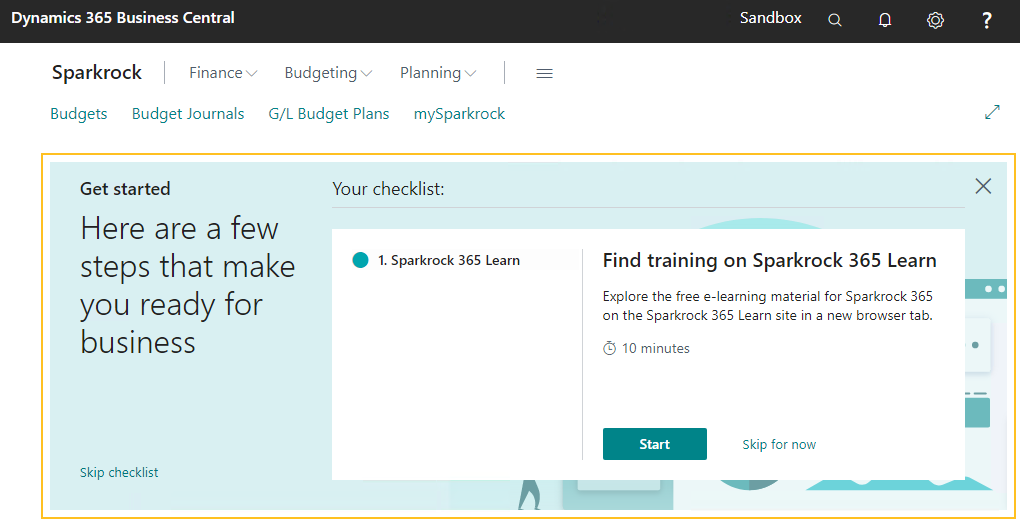
This guided experience provides the capability for new users to explore the free elearning material that is available for Sparkrock 365 on the learn.sparkrock365.com site.
For information about how to set up a guided experience on a role center, see Set up a Guided Experience.
Renamed list page captions
To improve naming consistency across pages, this release updates any pages that included List in the page caption to have a plural version of the caption on the related card page.
The following table includes some examples.
| Earlier releases | Starting with this release |
|---|---|
| Cash Receipt List | Cash Receipts |
| Project List | Projects |
| Grievances List | Grievances |
Budgeting and Planning extension
This release introduces a Budgeting and Planning extension which provides the capability to define a budget plan that is composed of multiple budget sets. Each budget set can be set up so that budget contributors can only enter budget information for a range of general ledger accounts and dimensions. After budget information has been entered, the budget set can be sent through an approval process. The combination of all budget sets per plan are the basis for a company budget. Budget plans and budget sets decentralize the budgeting process. Multiple contributors can participate and the budget data can be consolidated before completing the budgeting process.
This extension is designed for users who have a full license and one of the following personas:
Budget Administrator: Administers budgets and the budget creation process.
Budget Set Contributor: Contributes to the budget.
Budget Set Approver: Approver of budget sets, not the whole budget. Can be one of multiple levels of approvers within an approval group.
For information about how to set up budgeting and planning, see Set Up Budgeting and Planning.
For information about Budgeting and Planning business functionality, see Budgeting and Planning.
Project and grant accounting enhancements
This release includes the following project and grant accounting enhancements.
Project and Grant Accounting role center
To provide users with a centralized location for all project and grant accounting functionality, this release introduces a Project and Grant Administrator role center.
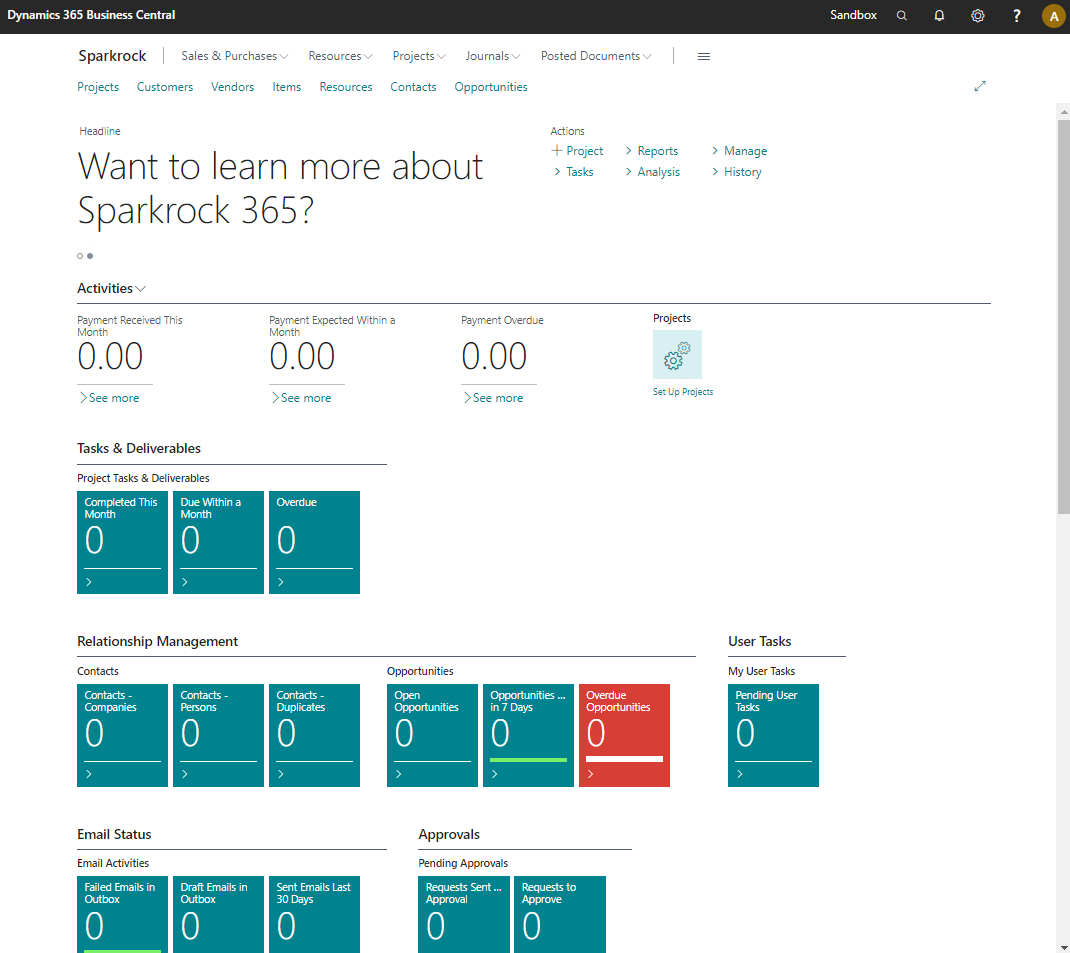
This role center provides the capability for users to access the following information and more:
Project setup information.
Project reporting information.
Payment information, such as payments that were received this month, are expected within a month, and are overdue.
Project tasks and deliverables information, such as tasks and deliverables that were completed this month, are due within a month, and are overdue.
Contact information, such as contact companies, persons, and duplicates.
Opportunities information, such as open opportunities, opportunities within the last 7 days, and overdue opportunities.
User tasks, email status, and approval information.
For more information about project and grant accounting, see Project and Grant Accounting.
No. of Account Sets field on the Projects and Project Card pages
On the Projects and Project Card pages, this release introduces on the Statistics FactBox, under Miscellaneous, a No. of Account Sets field.

The No. of Account Sets field specifies the count of account sets that are linked to the project dimension values that are specified for the project dimension. The project dimension is specified in the Project Dimension Code field on the Project Setup page.
Finance approval process enhancements
This release includes the following finance approval process enhancements.
Dimension approval workflows for purchase orders, purchase invoices, and purchase credit memos
This release introduces new finance dimension approval workflows for purchase orders, purchase invoices, and purchase credit memos.
Note
Note:
Dimension approval workflows include all workflows that can be configured on the Finance Approval Setup page. Dimension approval workflows can be grouped into the following functional areas:
- Finance requests, which include:
- Purchase requisitions
- Payment requests
- Expense claims
- Purchase documents, which include:
- Purchase orders
- Purchase invoices
- Purchase credit memos
These new workflows are based on the information on the lines. During the workflow, an approver can view the details for a document, including the one or more related document attachments, and then provide their approval before the document is posted.
The following functionality is supported:
Dimension approval for the following documents:
- Purchase orders
- Purchase invoices
- Purchase credit memos
Configuration of the following documents to exclude lines:
- Purchase orders: Exclude lines that are coming from a purchase requisition.
- Purchase invoices: Exclude lines that are coming from a requisition, payment request, or expense claim.
- Purchase credit memos: Exclude lines that are coming from a payment request or expense claim.
Amount based approvals, with multiple levels of approvers at different amount thresholds
Over budget approvals for purchase orders and purchase invoices that are triggered when a request depletes the budget that is linked to the account set, dimensions, or general ledger account
Over budget approval for purchase credit memos are not supported.
Direct approvals where an employee's direct manager or an approval group for finance approval purposes is specified on the mySparkrock User Setup Card page
Alternate approvers per document type
Approver types of mySparkrock User and Approval Groups
Approval group settings of All Must Approve and Notification Only
Specifying document types on the finance approval rules
Self-approval options and approval level on the Finance Approval Setup page
Standard delegates functionality when approving outside of the Finance Department Manager role center
Administrative approvers
Override approvals setting on the Finance Approval Rules page
Email notifications and email reminders
Users that have the Finance Department Manager role can approve purchase orders, purchase invoices, and purchase credit memos from the Finance Department Manager role center. Security is applied to filter lines when a user approvers a purchase order, but is not applied to filter lines when a user approves purchase invoices or credit memos.
The notification email workflow for purchase orders, purchase invoices, and purchase credit memos dimension approval workflows is different than the notification email workflow for other finance requests. For more information, see Notification Email Workflow for Purchase Document Dimension Approval Workflows.
For more information about this feature, see Set Up Finance Approvals.
For information about update considerations, see New dimension approval workflow templates for purchase orders, purchase invoices, and purchase credit memos.
New document types on the Finance Approval Setup and Approval Rule Document Types pages
On the Finance Approval Setup and the Approval Rule Document Types pages, this release introduces the following values for the Document Type field:
Purchase Order
Purchase Invoice
Purchase Credit Memo


The Enabled checkbox on the Finance Approval Setup page, can only be selected when no other approval workflow is active for the respective document type.
For information about update considerations for this feature, see Approval rule document types.
New fields on purchase document pages
To assist users of finance approval workflows, the following fields have been added to the Purchase Order, Purchase Invoice, Purchase Credit Memo, and Purchase Receiving pages:
Created By: Specifies the user who created the record.
Created At: Specifies the date and time that the record was created.
Last Modified By: Specifies the last user who changed the record.
Last Modified At: Specifies the last date and time that the record was updated.
Created by mySparkrock User: Specifies the mySparkrock user who created the record.
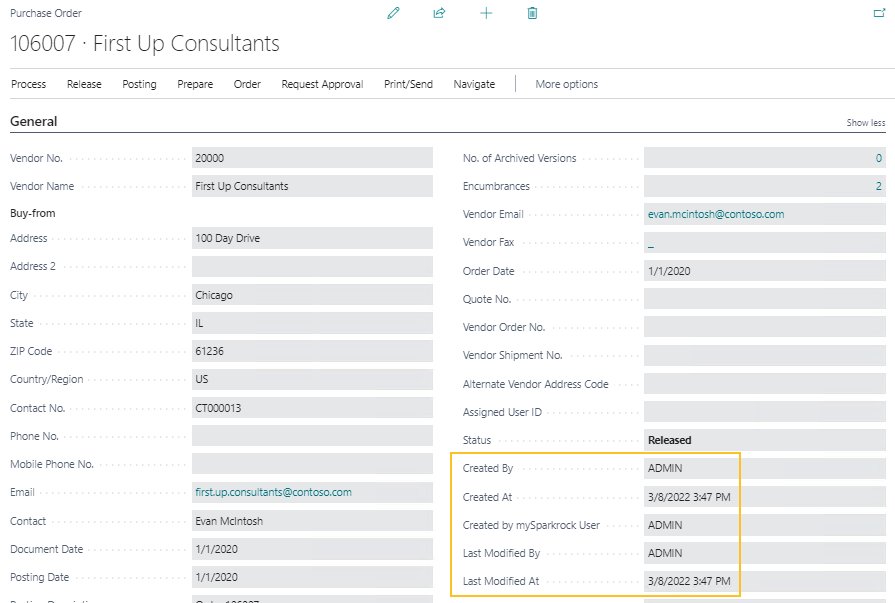
These fields are hidden by default. To make these fields visible, you must personalize your workspace. For more information, see Personalize Your Workspace.
Prevent users from changing dimensions and PR type when the dimension workflow for the respective document is enabled
When the dimension workflow for a purchase order, purchase invoice, or purchase credit memo is enabled and the Status of the respective document is not equal to Open, users are prevented from changing the dimensions or the PR type. When a users tries to change a dimension or PR type, an error appears that includes text that is similar to the following text:
Status must be equal to 'Open' in Purchase Header: Document Type=Order, No.=106001. Current value is 'Pending Approval'.
New Approval FactBoxes
On the following pages, this release introduces Approval and Pending Approval FactBoxes:
Purchase Requisition
Payment Request
Expense Claim
Purchase Order
Purchase Invoice
Purchase Credit Memo
The FactBox that appears depends on the user who accesses the page and the status of the purchase document.
If a document is sent for approval and the user who accesses the page is not the approver, a FactBox that is similar to the following FactBox appears:
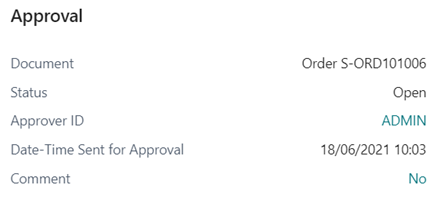
If a document is sent for approval and the user who accesses the page is the approver, a FactBox that is similar to the following FactBox appears:

After the document is approved, a FactBox that is similar to the following FactBox appears:
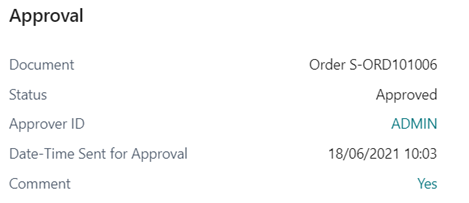
Approval email reminders
To help with the timely processing of purchase documents, this release introduces the capability for you to set up email reminders to remind approvers about documents that are awaiting their approval. To support this feature, on the Email Reminders Setup page, in Reminder Type, this release adds a Purchase Document option. This option applies to purchase order, purchase invoice, and purchase credit memo documents.
Reminders are sent for documents that meet the following criteria:
Document Status = Pending Approval
Approval entries Status = Open
Approval entries Notification Only = Not selected
Notification only users do not receive reminder emails because they are not required to approve.
Sparkrock 365 uses the following logic to determine to who to send an email reminder:
An email is sent to the user or group that is defined in sequence 1 or the direct approver
Next levels after the previous level has provided their approval
The reminder email indicates whether the approver is a direct approver, over budget approver, or an alternate.
To determine the recipient of the email, Sparkrock 365 uses the email address that is specified on the mySparkrock User Setup Card page. The sender of the email can be configured. For more information, see Set Up Email.
Reminder emails for purchase orders, purchase invoices, and purchase credit memos can only be enabled when on the Finance Approval Setup page, the dimension approval workflow for the respective document type is enabled. Reminder emails cannot be enabled for other types of approval.
For more information about email reminders, see Set Up Email Reminders.
New fields on the mySparkrock User Alternates and My Alternates pages
This release introduces the following fields on the mySparkrock User Alternates and My Alternates pages:
Purchase Order Approval: Specifies that this user can approve purchase orders on your behalf when the dimension approval workflow for this document type is enabled.
Purchase Invoice Approval: Specifies that this user can approve purchase invoices on your behalf when the dimension approval workflow for this document type is enabled.
Purchase Cr. Memo Approval: Specifies that this user can approve purchase credit memos on your behalf when the dimension approval workflow for this document type is enabled.


These fields are only displayed when on the Finance Approval Setup page, the dimension approval workflow for the respective document type is enabled.
New columns on the Finance Approval Setup page
This release introduces on the Finance Approval Setup page, the following columns:
Skip Requisition Lines: Specifies whether to skip lines that originate from a requisition when processing the approval for this document.
Skip Payment Request Lines: Specifies whether to skip lines that originate from a payment request when processing the approval for this document.
Skip Expense Claim Lines: Specifies whether to skip lines that originate from an expense claim when processing the approval for this document.
Finance Functional Area has been replaced on User Notification Settings
On the User Notification Settings page, this release replaces the Functional Area of Finance with the following new options:
Purchase Requisitions
Payment Requests
Expense Claims
Purchase Orders
Purchase Invoices
Purchase Credit Memos
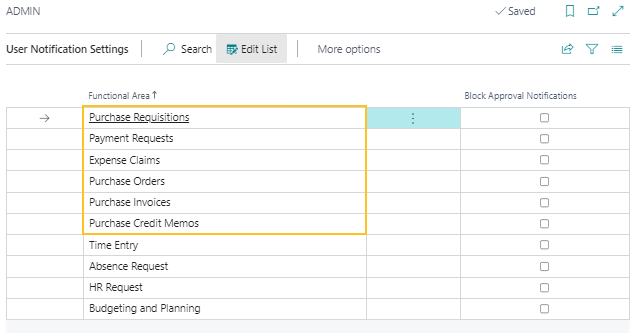
Each line provides the capability for you to block approval emails for the respective document type.
The Purchase Orders, Purchase Invoices, and Purchase Credit Memos options only appear when on the Finance Approval Setup page, the dimension approval workflow for the respective document is enabled.
Users who have the Finance Department Manager role, can can set up their personal notification settings for these new options from the Finance Department Manager role center or HR Department Manager role center, under Administration > My Notification Settings.
For information about update considerations for this change, see Block Approval Notifications checkboxes are updated automatically.
New process for when the last level approver for a finance request is a requester
This release changes how Sparkrock 365 processes finance approval requests where the last level approver is a requester.
Consider the following scenario:
On the Finance Approval Setup page, Approval Level is set to Last Level Approves.
The respective document type allows self-approval.
The requester is an approver at a threshold that is higher than the threshold for the document. The requester can be a mySparkrock user or part of an approval group.
Now, when this scenario occurs, the approval process skips all other rules and thresholds, and the document is automatically approved.
For more information, see Last level approver is a requester.
Accounts payable batch management enhancements
This release includes several enhancements to the Sparkrock 365 Accounts Payable (A/P) batch management functionality.
Move purchase documents from a batch to another open batch
Starting with this release, Sparkrock 365 provides the capability for you to move purchase documents, such as purchase invoices or purchase credit memos, from an accounts payable (A/P) batch to another open batch. This feature is useful in situations where a document is not approved for some reason, but the batch must be processed so other vendors can be paid.
To support this change, on A/P batch purchase document pages, this release introduces the Move To Batch action.

On the Purchases & Payables Setup page, when Enable A/P Batch Management is turned on and a user opens a purchase document page, such as A/P Batch Purchase Invoices, a user can select one or more purchase documents, and then choose the Move To Batch action to move the one or more documents to a different open A/P batch.
Users who have on the User Setup page, the A/P Batch Admin checkbox selected, can move purchase documents to any other open A/P Batch. Otherwise, if the A/P Batch Admin checkbox is clear for a user, the user can only move purchase documents to another batch that they created. If no open batch exists, the user can create a batch after choosing the action.
Purchase documents cannot be moved from an open batch to a non-open batch, for example, from a batch with the Status of Open to a batch with the Status of Released. However, for purchase documents that are not posted, the documents can be moved from a non-open batch to an open batch, for example, from a batch with the Status of Released to a batch with the Status of Open.
For more information, see Move a Purchase Document from one Accounts Payable Batch to Another Open Batch.
Place open accounts payable batches on hold
This release introduces the capability for users to indicate that certain open accounts payable batches are on hold. This feature is useful when certain documents in the batch are held up for some reason and are not to be processed further, for example, when you do not want a batch to move to the Released, Audited, or Posted states.
To support this feature, this release introduces on the A/P Batch Card page, a new On Hold field.
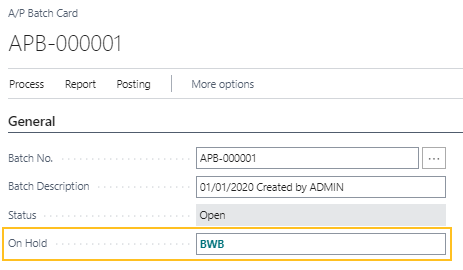
A value in the On Hold field indicates that the batch is on hold. The value includes the initials of the user who is responsible for placing this batch on hold.
Users who have on the User Setup page, the A/P Batch Admin checkbox selected, can update the On Hold field of each batch. Otherwise, if the A/P Batch Admin checkbox is clear for a user, the user can only place their own batches on hold.
An on hold batch can be processed, but a warning is displayed to the user. If the user chooses to continue, Sparkrock 365 removes the value in the On Hold field automatically.
For more information, see Place an Accounts Payable Batch on Hold.
A/P Batches page enhancements
This release includes the following enhancements to the A/P Batches page:
The default soft order is now from newest to oldest.
22322 To improve performance, all fields that start with No. of, for example, No. of Unreleased Invoices are now hidden by default.
If required, these fields can be made visible again with the personalization feature. For more information, see Personalize Your Workspace.
22322 To be consistent with the design of other pages, on the action bar, the Filters action group has been removed. Filtered views are now available from the Filter pane.

22324
New Batch Summary FactBox on the A/P Batches and A/P Batch Card pages
This release introduces on the A/P Batches and A/P Batch Card pages, a new Batch Summary FactBox.
The Batch Summary FactBox includes the following fields:
Batch Total (LCY): Specifies the total amount including tax in the local currency for all unposted and posted purchase invoices and purchase credit memos that are in the batch.
Total Documents: Specifies the total number of documents that exist in the batch.
22648
Accounting Manager role center enhancements
This release includes the following Accounting Manager role center enhancements.
Trial balance information on the Accounting Manager role center
On the Accounting Manager role center, in the Insights section, this role center now includes trial balance information.
Removal of activity buttons from the Accounting Manager role center
To improve consistency with other role centers, this release removes the following buttons from the Activities section of the Accounting Manager role center:
Product Videos
G/L Journal Entry
Recurring G/L Entry
Payment Journal Entry
21975
Purchase receiving enhancements
This release introduces the following receiving related enhancements.
Direct Unit Cost, Add Remaining Amount (\(), and Rmng. Amt. Incl. Tax Exp. (\)) fields on the Purchase Receiving page
On the Purchase Receiving page that is accessed from the Finance Department Manager role center, on the Lines FastTab, this release introduces the following fields:
Direct Unit Cost: Specifies the cost of one unit of the selected item or resource.
Remaining Amount ($): Specifies the remaining amount before tax on the line in the local currency.
Rmng. Amt. Incl. Tax Exp. ($): Specifies the remaining amount including tax expense on the line in the local currency.
These fields are hidden by default. To make these fields visible, you can use the personalization feature. For more information, see Personalize Your Workspace.
Remaining Amount (\() and Rmng. Amt. Incl. Tax Exp. (\)) on the Purchase Order page
On the Purchase Order page that is accessed from the Finance Department Manager role center, on the Lines FastTab, this release introduces the following fields:
Remaining Amount ($): Specifies the remaining amount before tax on the line in the local currency.
Rmng. Amt. Incl. Tax Exp. ($): Specifies the remaining amount including tax expense on the line in the local currency.
These fields are hidden by default. To make these fields visible, you can use the personalization feature. For more information, see Personalize Your Workspace.
PO Information FactBox
Starting with this release, users who have the Finance Department Manager role, can now view the PO Information FactBox on the following list and card pages:
Purchase Orders
Purchase Order
Purchase Receiving
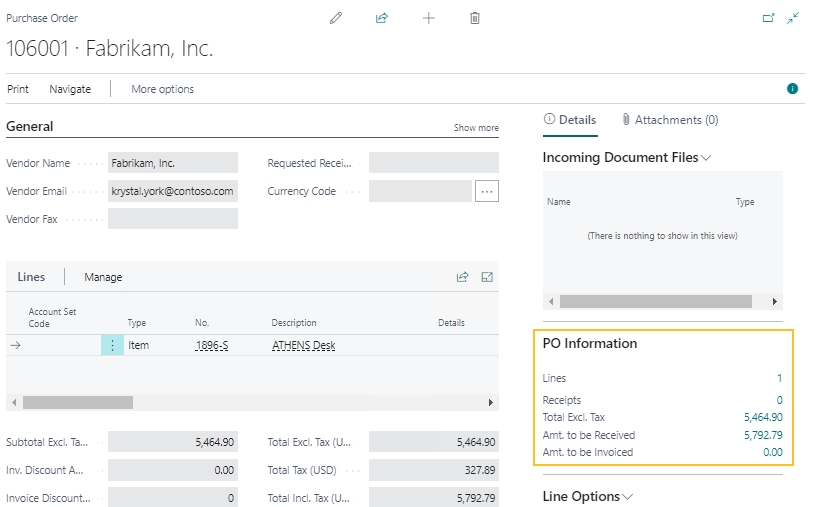
In this FactBox, the link that appears for the Receipts value can be selected to open the related Posted Purchase Receipts page.
Tile changes on the Purchasing Agent role center
On the Purchasing Agent role center, this release adds the Not Received cue and removes the Received cue.
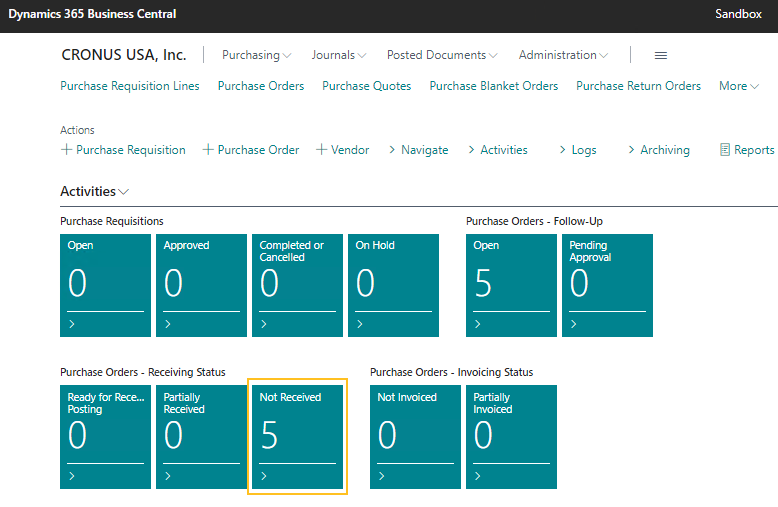
The Not Received cue displays a count of the purchase orders that are not received.
New views and Completely Received field
On the Not Received and Purchase Orders pages, this release introduces the following views that provide the capability to filter the purchase orders that are displayed based on the receiving status:
All
Received
Partially Received
Not Received
Not Invoiced
Partially Invoiced
Also, on the Purchase Orders page, a Completely Received field has been added. The Completely Received field specifies whether all items on the purchase order have been completely received from the vendor.

Price list enhancements
This release includes the following price list enhancements.
Price list Unit Amount Type defaults from the Expense Type
Starting with this release, when a user adds a line on a Price List page, the value in Unit Amount Type on the Price List Lines page of any related expense types is defaulted. The default value is based on the setup of the respective Expense Type Card page. If required, the value in Unit Amount Type can be changed.
Expense Type Details FactBox on the Price List page
To help with troubleshooting and making better choices, this release introduces on the Price List page, an Expense Type Details FactBox.

Finance Department Manager enhancements
This release includes the following enhancements for users who have the Finance Department Manager role.
Preview an attachment capability for Finance Department Manager role
For users who have the Finance Department Manager role, this release introduces the capability to preview an attachment. An attachment can be previewed on the Attached Documents page, in the Picture FactBox.
Note
Note:
Some attachments cannot be previewed due to their file type.
Finance Department Manager permission set
For finance department manager users, this release introduces the following permission set:
Permission Set: SRF FINANCE DEPT MGR
Name: Finance Department Manager
Type: System
Extension Name: Finance and Procurement
Users who have the Finance Department Manager permission set, must also have the following permission set:
Permission Set: D365 TEAM MEMBER
Name: Dynamics 365 Team Member
Type: System
Extension Name: Base Application
21975
Attachments support for limited access purchase documents
This release introduces attachment support for limited access purchase orders. On the Purchase Orders or Purchase Order pages, limited access users can now view incoming documents or attachments that are attached to the purchase order. The attachments appear in the Attachments and Incoming Document Files FactBoxes. Limited access users can view the attachments, but cannot edit or delete the incoming documents or attachments.
Also, to be consistent with what is displayed on card pages, this release adds the Attachments and Incoming Document Files FactBoxes to the limited access Posted Purchase Credit Memos and Posted Purchase Invoices pages.
Fixed asset enhancements
This release includes the following enhancements for fixed assets.
No. on Purchase Lines field on the Fixed Asset Card page
Starting with this release, on the Fixed Asset Card page, the No. on Purchase Order field now correctly counts the number of purchase orders with purchase order lines, including TCA fixed and pooled assets.
Fixed Asset Card page Vehicle Year and Vehicle License Plate fields
In Microsoft Dynamics 365 Business Central 20.0, Microsoft introduced on the Fixed Asset Card page, Vehicle Year and Vehicle License Plate fields.

These new fields replace the Vehicle Year and Vehicle License Plate fields that Sparkrock had created in an earlier release.
For information about update considerations, see Move Vehicle Year and Vehicle License Plate data.
Default display of dimension fields on the Fixed Assets page
Starting with this release, to determine the dimension code fields that are visible by default on the Fixed Assets page, Sparkrock 365 uses the setup on the Dimensions FastTab of the General Ledger Setup page.
If required, these fields can be hidden with the personalization feature. For more information, see Personalize Your Workspace.
Contract enhancements
This release includes the following enhancements for contracts.
Default display of fields on the Contracts page
To highlight the most important information, this release reduces the number of fields that appear by default on the Contracts page.
If required, hidden fields can be displayed with the personalization feature. For more information, see Personalize Your Workspace.
Replace Active Certifications field with an Active Certifications FactBox
On the Contracts and Contract Card pages, this release introduces an Active Vendor Certifications FactBox, which lists each active certification.
This FactBox replaces the Active Certifications field, which was removed in this release.
Replace the Filters action group on the Vendor Certifications page with new views
To improve consistency with other pages, on the Vendor Certifications page, this release replaces the Filters action group with the following views:
Active: Only active entries are displayed.
Inactive: Only inactive entries are displayed.
21975
Rename Commitment G/L Account field to Encumbrance G/L Account
To be consistent with the terminology that is used on other pages, on the Item Card page, on the Inventory FastTab, the Commitment G/L Account field has been renamed to Encumbrance G/L Account.
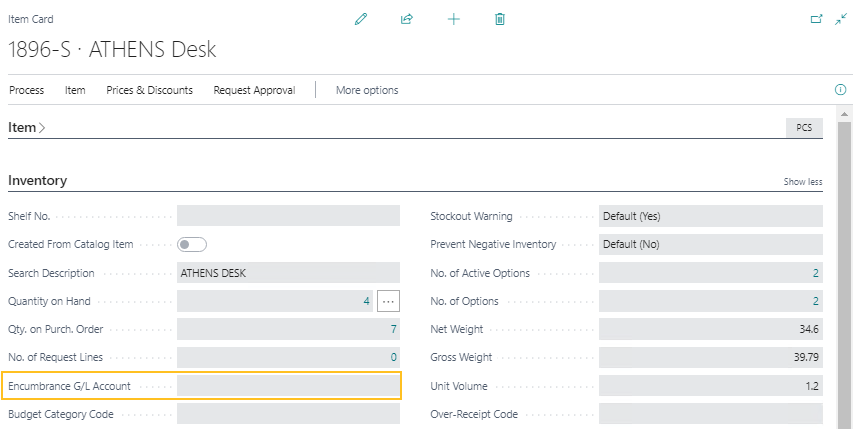
Automatically update existing purchase order posting date
Before this release, when the Default Posting Date field on the Purchases & Payables Setup page was set to Work Date, and then the Purchase Order page was opened for an existing purchase order, the Posting Date field was automatically updated to the work date. To provide the capability to prevent the Posting Date on an existing purchase order from updating automatically when the Purchase Order page is opened, this release introduces on the Purchases & Payables Setup page, an Auto Update Purchase Order Posting Date field.

When Auto Update Purchase Order Posting Date is turned on and the Default Posting Date field is set to Work Date, and then the Purchase Order page is opened for an existing purchase order, the Posting Date is automatically updated to the work date. Also, similar to what happens when the Posting Date is changed manually, all relevant fields are automatically updated.
Alternatively, when Auto Update Purchase Order Posting Date is turned off, and then the Purchase Order page is opened for an existing purchase order, the Posting Date is not updated.
Note
Note:
The Auto Update Purchase Order Posting Date field setting is only applicable when the Default Posting Date field is set to Work Date.
For information about update considerations, see Automatically update posting date on existing purchase orders.
Enhanced attendance approvals
This release includes the following attendance approval enhancements.
Mass update Approval Group Code on attendance plan lines
In previous releases, on the Attendance Plan page, if a change was required to the Approval Group Code on the lines, each line had to be updated individually. Starting with this release, a user can update the new Approval Group Code field on the General FastTab to perform a mass update of all related attendance plan lines and linked employee attendance plan lines.
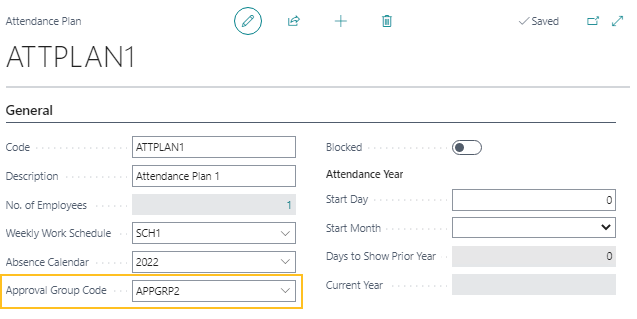
When a user adds or updates the value of Approval Group Code on the General FastTab, a dialog box appears and displays the following text:
You have modified the Approval Group Code. Do you want to update the lines, related employees and all linked employee attendance plan lines?
If the user chooses Yes, the following fields are updated with the new value:
The Approval Group Code field on the General FastTab of the Attendance Plan page.
The Approval Group Code field on the Attendance Plan FastTab of the Employee Attendance Plan page.
The Approval Group Code field on all related attendance plan lines that have a cause of absence with the Type of Entry.
The Approval Group Code field on all linked employee attendance plan lines that have a cause of absence with the Type of Entry.
Alternatively, if the user chooses No, only the value on the General FastTab is updated.
When a user deletes the value of the Approval Group Code on the General FastTab, a dialog box appears and displays the following text:
You have modified the Approval Group Code. Do you want to remove the Approval Group Code from all the lines, related employees and all linked employee attendance plan lines?
If the user chooses Yes, the following fields are updated to have a value of blank:
The Approval Group Code field on the General FastTab of the Attendance Plan page.
The Approval Group Code field on the Attendance Plan FastTab of the Employee Attendance Plan page.
The Approval Group Code field on all related attendance plan lines that have a cause of absence with the Type of Entry.
The Approval Group Code field on all linked employee attendance plan lines that have a cause of absence with the Type of Entry.
Alternatively, if the user chooses No, only the value on the General FastTab is updated to have a value of blank.
Mass update Approval Group Code on employee attendance plan lines
In previous releases, on the Employee Attendance Plan page, if a change was required to the Approval Group Code on the lines, each line had to be updated individually. Starting with this release, a user can update the new Approval Group Code field on the Attendance Plan FastTab to update all related employee attendance plan lines automatically.

When a user adds or updates the value of Approval Group Code on the Attendance Plan FastTab, a dialog box appears and displays the following text:
You have modified the Approval Group Code. Do you want to update the lines?
If the user chooses Yes, the Approval Group Code field on the Attendance Plan FastTab and the Approval Group Code field on all related lines that have a cause of absence with the Type of Entry are updated with the new value.
Alternatively, if the user chooses No, only the value on the Attendance Plan FastTab is updated.
When a user deletes the value of the Approval Group Code on the Attendance Plan FastTab, a dialog box appears and displays the following text:
You have modified the Approval Group Code. Do you want to remove the Approval Group Code from all the lines?
If the user chooses Yes, the Approval Group Code field on the Attendance Plan FastTab and the Approval Group Code field on all related lines that have a cause of absence with the Type of Entry are updated to have a value of blank.
Alternatively, if the user chooses No, only the value on the Attendance Plan FastTab is updated to have a value of blank.
Default Approval Group field on the HR Position Card page
On the HR Position Card page, on the General FastTab, this release introduces a Default Approval Group Code field.

The Default Approval Group Code field specifies the code that represents the default approval group for this position.
When the Default Approval Group Code field has a value other than blank and an HR request is created for that position, the Approval Group Code on the HR request is automatically populated with the Default Approval Group Code value. If required, the default value can be changed.
Note
Note:
During HR request processing, the Approval Group Code field that is specified on the HR request takes precedence over the Approval Group Code that is specified on attendance plan lines that are assigned to an employee.
HR Approval Setup
For customers who have the HR Management extension installed, this release introduces an HR Approval Setup page.
The HR Approval Setup page provides the capability to set up distinct system-wide approval request processes for the following document types:
Absence Request
HR Request
Time Entry
This option only appears when the Sparkrock 365 Time Entry extension is installed.
Authorized users can access the HR Approval Setup page with the Tell Me feature and from the Security Administrator role center. To access the page from the Security Administrator role center, choose Approvals > HR Approval Setup.
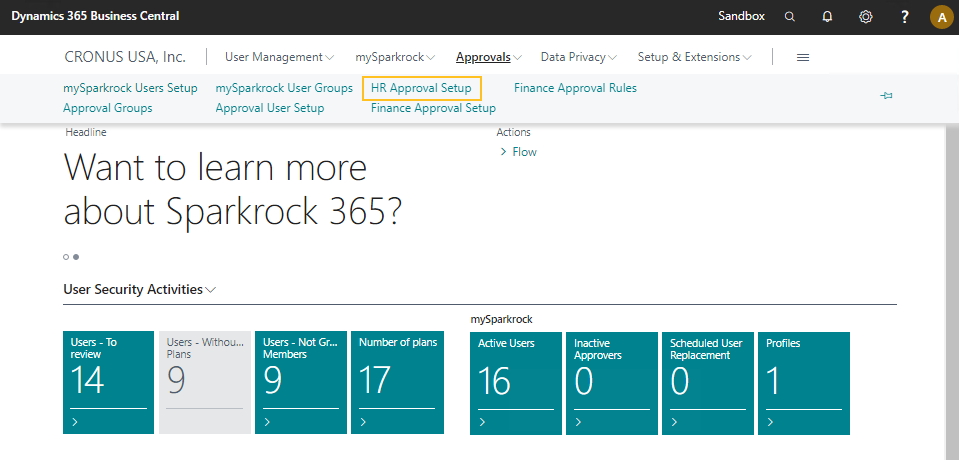
For more information see, Set Up the HR Approval Setup page.
For information about update considerations, see Enable Absence Request and HR Request approval workflows and Enable Time Entry approval workflow.
HR request status views
On the HR Requests page, this release introduces views that provide the capability to filter the HR requests that are displayed based on the Status of the HR request. These views can be chosen in the Filter pane.
The following views are available:
All
Open
Pending HR Action
Pending Payroll Action
Completed
Show balances and create entries fields on the Employee Attendance Plan page are now editable
On the Employee Attendance Plan page, the following fields are now editable:
Show Balances - Employee
Create Entries - Employee
Show Balances - Manager
Create Entries - Manager

Terminology change from Entitlement to Accrual
To make Sparkrock 365 consistent with the terminology that is commonly used in Canada and US markets, this release changes all references of Entitlement to Accrual, for example, the Annual Entitlement Worksheet page is now the Annual Accrual Worksheet page.
Teaching tours
To help new users get started, this release introduces teaching tours on the following pages:
Employees
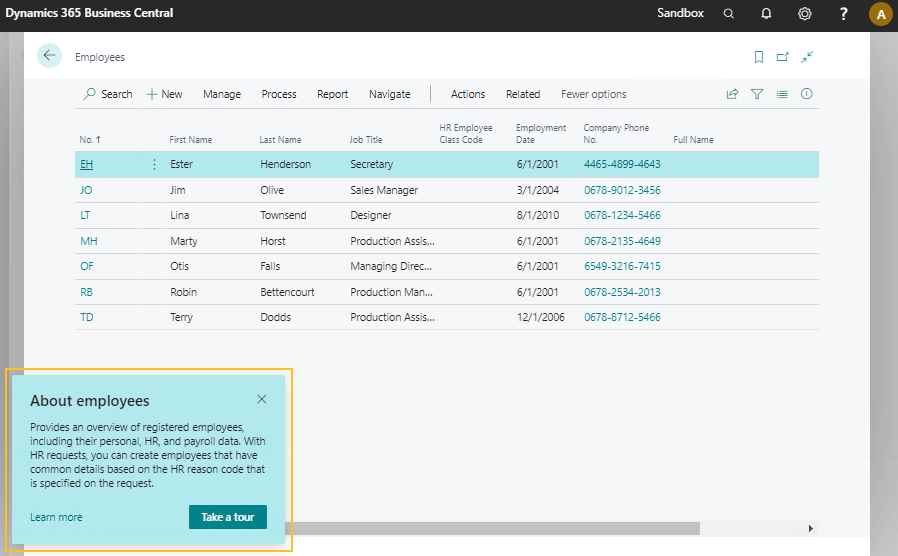
Employee Card
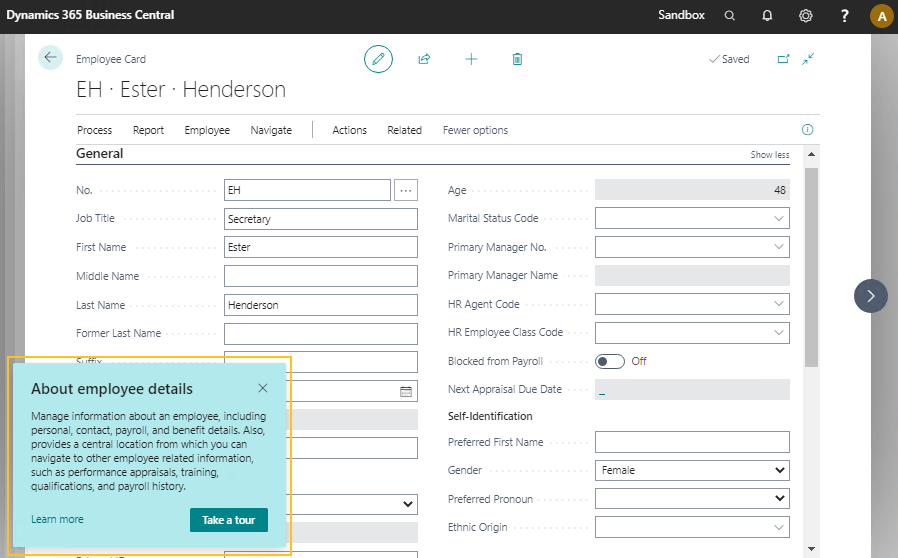
HR Requests
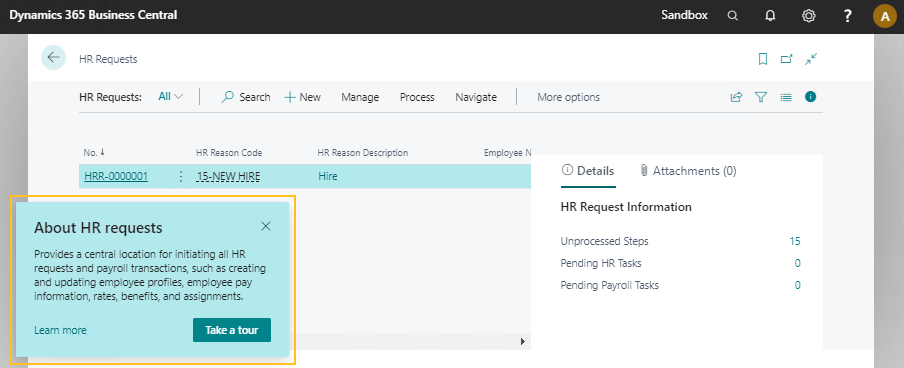
HR Request
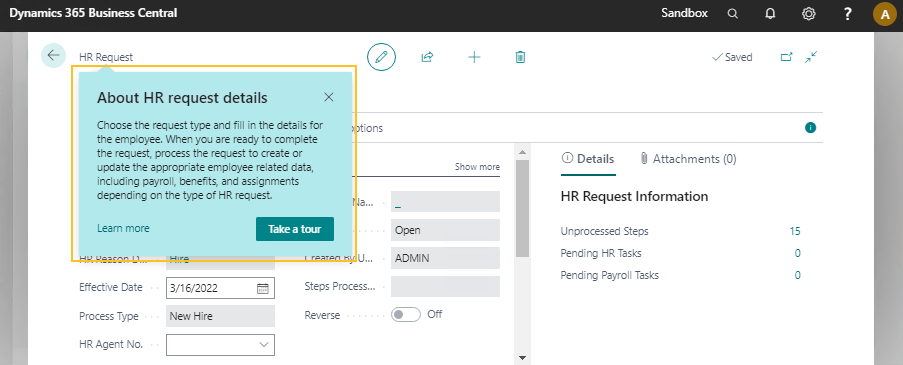
Teaching tours include short messages that inform, remind, or teach users about important and new capabilities. For more information about teaching tours and tips, see Teaching tips and tours and Teaching tips.
New Ontario English Catholic Teachers Association (OECTA) Connector extension
This release introduces an Ontario English Catholic Teachers Association (OECTA) Connector extension, which you can use to manage and create the OECTA membership fee export file. This extension replaces all existing OECTA functionality from earlier releases of Sparkrock 365.
To meet the latest OECTA file export requirements, this release includes the following new features and changes to the OECTA functionality in Sparkrock 365:
On the HR Integration Setup page, the ON - English Catholic Teachers Association FastTab has been removed. This setup information is now available on the new OECTA Connector Setup page.
The following new fields are included on the OECTA Worksheet page and in the export file:
- Permanent Member Start Date (MemStartDate)
- Permanent Member Termination Date (MemTermDate)
- Permanent FTE
- LTO FTE
- Permanent Member Leave Status (MemLeaveStatus)
- Board Email Address (BoardEmail)
The following fields have been updated on the OECTA Worksheet page and in the export file:
- Pay Period (PayPeriod)
- Member Type (MemType)
- Member Status (MemStatus)
- Member Panel (MemPanel)
The following fields have been removed from the OECTA Worksheet page and the export file:
- Ministry School ID (Mident)
- FTE
- Pay Period End Date (PayEndDate)
The new Permanent FTE and LTO FTE field values are based on the union code setup.
On the OECTA Connector Setup page, the Retired Status ROE Reason Codes field determine which codes in the export file are specified as retired in the Member Status (MemStatus) field.
For more information about update considerations, see Move OECTA Connector setup data.
For more information about the OECTA Connector, see OECTA Connector.
Payroll updated to 19.23.0.0
To stay current with the latest payroll updates and fixes, payroll has been updated to 19.23.0.0. To view a detailed list of the updates that are available, see Payroll releases.
Retro pay enhancements
This release includes the following retro pay enhancements.
Grounds for termination for retro pay
Starting with this release, the grounds for termination creation process now accounts for cases where an employee has retro pay entries. In cases where employees receive retro pay, the grounds for termination creation uses the actual days that were worked.
The following scenarios demonstrate how grounds for termination detail lines now appear.
Scenario 1:
Employee was hired on 10/31/2021.
3 pays were processed.
Employee was terminated on 12/12/2021.
In this scenario, the grounds for termination details lines appear as displayed in the following table.
| Start Date | End Date | Amount |
|---|---|---|
| 11/28/2021 | 12/11/2021 | $1,837.18 |
| 11/14/2021 | 11/27/2021 | $1,837.18 |
| 10/31/2021 | 11/13/2021 | $1,837.18 |
| $145.00 |
Scenario 2:
Employee was hired on 11/14/2021.
Retro date is 10/31/2021.
2 pays were processed. The first pay includes retro pay for the pay that was missed.
Employee was terminated on 12/12/2021.
In this scenario, the grounds for termination details lines appear as displayed in the following table.
| Start Date | End Date | Amount |
|---|---|---|
| 11/28/2021 | 12/11/2021 | $1,837.18 |
| 11/14/2021 | 11/27/2021 | $3,049.34 |
| $95.00 |
Retro pay detail entries
Also, starting with this release, after lines are processed on the Retro Pay Worksheet page, retro pay detail entries are available for you to view from the following pages:
HR Request-One Time Payment
Compensation Journal
Compensation Ledger Entries
To view retro pay detail entries from the HR Request-One Time Payment page, on the action bar, choose Retro Pay Detail Entries.
To view retro pay detail entries from the Compensation Journal page, select the applicable retro pay line, and then on the action bar, choose Related > Retro Pay Detail Entries.
To view retro pay detail entries from the Compensation Ledger Entries page, select the applicable retro pay line, and then on the action bar, choose Related > Retro Pay Detail Entries.
Additional dates are automatically populated when a Retro Date is specified on an HR request
Starting with this release, on the Details page of an HR request that has the Process Type of New Hire, Rehire, or Additional Assignment and a value is specified in the Retro Date field, the following date fields on the HR request are now updated automatically with the retro date:
Assignment Start Date
Benefit Eligibility Date or Effective Date on the Employee Benefits FastTab
The Benefit Eligibility Date continues to be updated based on the existing logic when the Benefit Effective Date is changed.
Vacation Credit Date
Seniority Date
The Seniority Date is only updated in cases where it is automatically populated. Otherwise, the existing logic continues to be used.
21451
For more information about retro pay functionality, see Retro Pay.
Retro Pay Detail Lines manual line deletion
On the Retro Pay Detail Lines page, this release introduces the Delete Manually Created Line action.

This action provides the capability to delete entries that have a Record Source of Manually Created.
Payroll Processing Group Code on an HR request
On the Details page of an HR request that has the Process Type of New Hire or Rehire, this release introduces a Payroll Processing Group Code field.

In the Payroll Processing Group Code field, a group can be specified that can be used to filter employees during payroll processing. These groups provide the capability to run payroll processing for specific employees, instead of all employees.
When a value is specified in the Payroll Processing Group Code field, and then the HR request is successfully processed, on the respective Employee Card page, in the Payroll Processing Group Code field, the same value is automatically populated.
For more information about payroll processing groups, see Set Up Payroll Processing Groups.
Pay Period No. field on the HR Pay Cycle Periods page
On the HR Pay Cycle Periods page, this release introduces a Pay Period No. field.

This field specifies the number of the pay period. Authorized users can edit this field as required.
The Pay Period No. field is automatically populated or updated with the Update Salary Deferral Setups action. For more information about the Update Salary Deferral Setups action, see Set Up Salary Deferrals.
Mass publish schedules
This release introduces the capability for you to publish all schedules at once. When you mass publish schedules, you can specify filters, such as:
Pay cycle
Area
Schedule unit
Work dates
To accommodate this new feature, this release includes the following changes to Sparkrock 365:
The Mass Validate Schedules task has been renamed to Mass Validate and Publish Schedules.
The Publish field has been added to the renamed Mass Validate and Publish Schedules page.

The new Publish field determines whether shifts are to be published after the shifts are validated.
When you mass publish schedules, the Publish Validation Level on the Schedule Setup page is taken into consideration.
For more information, see Mass Validate and Publish Schedules.
Warning exceptions by position
To meet the employment standard requirements of customers, this release introduces the following new functionality:
The capability to display different warning messages to an employee depending on the employee's primary position.
To determine the primary position, Sparkrock 365 uses the assignment with the lowest rank.
A new monthly maximum hours warning.
For more information, see Warning Exceptions by Position
The following sections describe the enhancements that have been completed in Sparkrock 365 to support this feature.
Warning Exceptions by Position action and Month field on the Schedule Setup page
On the Schedule Setup page, there is a new Warning Exceptions by Position action.
When you choose the new Warning Exceptions by Position action, the new Warning Exceptions by Position page opens.
Also, there is a new Monthly Max Hours Warning field.
This field specifies for an employee, the total hours for the month threshold at which a warning is displayed to schedulers. Typically this threshold is used to identify situations that may trigger overtime.
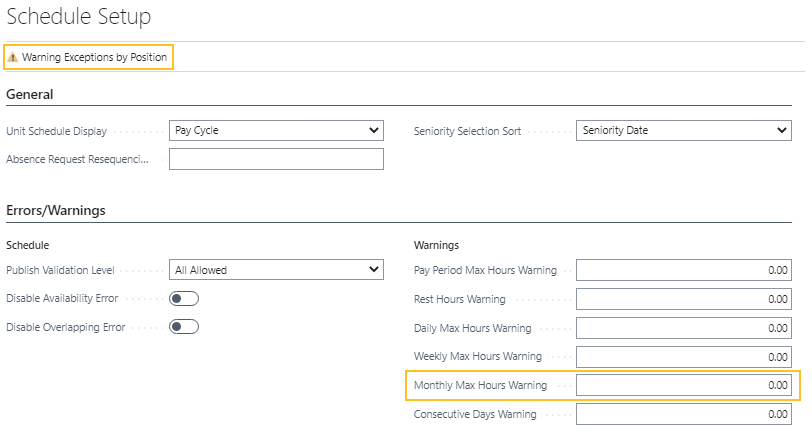
Warning Exceptions by Position page
To determine the schedule warning to display to an employee, Sparkrock 365 references the setup on the new Warning Exceptions by Position page.
Month field on the Employee Information FactBox
On the Schedule Card and Shift Card pages, in the Employee Information FactBox, this release introduces a Month field.

The Month field uses the same logic as the Week field multiplied by 4.
Warning logic for max hours
The warning logic has been enhanced for the max hours warnings for the primary assignment that is eligible for scheduling as of the shift work date. If the position from the primary assignment is set up on the Warning Exceptions by Position page, these values are used to determine the warning that appears. Otherwise, the warning logic uses the values that are set up on the Schedule Setup page.
The warning logic has also been enhanced to support the new monthly settings. On schedule templates, the monthly warning uses the logic for weekly warnings multiplied by 4. On schedules, the month start and end dates are used.
Update considerations
The following sections include information about update considerations for Sparkrock 365 2022 release wave 1.
All users must have the LOGIN permission set
This release requires that all users have the LOGIN permission set. For more information about the LOGIN permission set, see Special Permission Sets.
mySparkrock authentication setup changes due to OAuth 2.0 authentication method update
As a result of the mySparkrock OAuth 2.0 authentication method update in this release, when updating to this release in a SaaS configuration, several setup tasks must be performed.
Note
Note:
Sparkrock Cloud customers and on-premise configurations can continue to use the web service key authentication mode.
The following sections include details about the specific setup tasks that must be performed.
Create the mySparkrock Application in Azure Active Directory Applications
On the Azure Active Directory Applications page, the mySparkrock application must be created.
Note
Note:
To complete all steps in this task, you must be an Azure Active Directory administrator.
To create the mySparkrock Application in Azure Active Directory Applications
Choose
 , enter azure active directory applications, and then choose the related link.
, enter azure active directory applications, and then choose the related link.The Azure Active Directory Applications page opens.
On the action bar, choose Create mySparkrock Application.
A new row appears for the mySparkrock application.
Ensure that the mySparkrock application record is selected, and then on the action bar, choose Manage > Edit.
The Azure Active Directory Application Card page opens.
If required, update fields.
To grant consent for mySparkrock to access data from Sparkrock 365, on the action bar, choose Grant Consent.
Log into Azure Active Directory and perform the required setup. For more information, see Using Service-to-Service (S2S) Authentication.
Create the mySparkrock User Card for the Internal User ID of MYSPARKROCK
To establish the connection between mySparkrock and Sparkrock 365, the following setup is required:
A mySparkrock user named MYSPARKROCK must exist.
For the MYSPARKROCK user, on the related mySparkrock User Card page, on the General FastTab, the Internal User ID must have a value of MYSPARKROCK.

When updating to this release, create a mySparkrock user named MYSPARKROCK.
To create a mySparkrock user named MYSPARKROCK
Choose
 , enter mysparkrock users, and then choose the related link.
, enter mysparkrock users, and then choose the related link.The mySparkrock Users page opens.
On the action bar, choose New.
The mySparkrock User Card page opens.
In User Name, specify MYSPARKROCK.
In Internal User ID, specify MYSPARKROCK.
On the Companies FastTab, specify values for fields as required.
To complete the setup of the mySparkrock User Setup Card page, select the Edit mySparkrock User Setup link.
The mySparkrock User Setup Card page opens.
No values are required to be updated.
To complete the setup of the mySparkrock User Setup Card page, choose Close.
Update Payroll Setup
For mySparkrock authentication to work correctly for payroll, on the Payroll Setup page, on the Payroll Users Setup FastTab, there must be a record with the User ID of MYSPARKROCK. Permissions can be assigned to the record with the User ID of MYSPARKROCK as required.
When updating to this release, create a record that has a User ID of MYSPARKROCK.
To create a record that has a User ID of MYSPARKROCK in Payroll Setup
Choose
 , enter payroll setup, and then choose the related link.
, enter payroll setup, and then choose the related link.The Payroll Setup page opens.
On the Payroll Users Setup FastTab, choose Manage > New Line.
A new row appears.
In User ID, specify MYSPARKROCK.
In other fields on the line, specify values as required.
Verify that the Notification Entry Dispatcher job queue entry has Recurring Job turned on
On the Job Queue Entry Card page of the Notification Entry Dispatcher job queue entry, Recurring Job must be turned on. Typically, when this job queue entry is setup, Recurring Job is turned on automatically. In the event that Recurring Job is turned off, you must manually turn on Recurring Job.
To manually turn on Recurring Job for the Notification Entry Dispatcher job queue entry
Choose
 , enter job queue entries, and then choose the related link.
, enter job queue entries, and then choose the related link.The Job Queue Entries page opens.
Select the record that has in Object Caption to Run, a value of Notification Entry Dispatcher, and then on the action bar, choose Edit.
The Job Queue Entry Card page opens.
If the Status of the job queue entry is Ready, on the action bar, choose Actions > Job Queue > Set On Hold.
The Status changes to On Hold.
Turn on Recurring Job.
To set the Status of the job queue entry to Ready, on the action bar, choose Actions > Job Queue > Set Status to Ready.
20918
New dimension approval workflow templates for purchase orders, purchase invoices, and purchase credit memos
To support the new Dimension approval workflows for purchase orders, purchase invoices, and purchase credit memos feature, this release adds on the Workflow Templates page, the following new dimension approval workflow templates:
Purchase Cr. Memo Dimensions Approval Workflow
Purchase Invoice Dimensions Approval Workflow
Purchase Order Dimensions Approval Workflow

Approval rule document types
To support the new document types on the Finance Approval Setup and Approval Rule Document Types pages feature in this release, for all records on the Finance Approval Rules page, that have Document Types set to All, this release updates the related Approval Rule Document Types page. The Approval Rule Document Types page is updated to have the Include checkbox selected for the document types of Purchase Order, Purchase Invoice, and Purchase Credit Memo.

Block Approval Notifications checkboxes are updated automatically
To support the Finance Functional Area has been replaced on User Notification Settings change in this release, the User Notification Settings and My Notification Settings pages may be updated automatically. For any users, who in an earlier release, had the Block Approval Notifications checkbox selected for the Functional Area of Finance, the update automatically selects the Block Approval Notifications checkboxes for the new functional areas of Purchase Requisitions, Expense Claims, and Payment Requests.
Note
Note:
Users must manually update the Block Approval Notifications checkbox for the new functional areas of Purchase Orders, Purchase Invoices, and Purchase Credit Memos because these are new options in this release.
Move Vehicle Year and Vehicle License Plate data
To support the Vehicle Year and Vehicle License Plate field changes in this release, during an update, all data from the Sparkrock created Vehicle Year and Vehicle License Plate fields is automatically moved to the Vehicle Year and Vehicle License Plate fields that Microsoft introduced as part of Microsoft Dynamics 365 Business Central 20.0.
Automatically update posting date on existing purchase orders
After updating to this release, to continue to have the Posting Date update automatically when the Purchase Order page is opened, you must turn on the Auto Update Purchase Order Posting Date field on the Purchases & Payables Setup page. For more information, see Automatically update existing purchase order posting date.
Enable Absence Request and HR Request approval workflows
To support the new HR Approval Setup feature, when customers that have the Absence Request, HR Request, or both workflows enabled update to this release, the Enabled checkbox is automatically selected for the row with the Document type of Absence Request or HR Request.
Move OECTA Connector setup data
To support the new OECTA Connector extension, when you update to this release, all setup data on the ON - English Catholic Teachers Association FastTab of the HR Integration Setup page is automatically moved to the new OECTA Connector Setup page.
Enable Time Entry approval workflow
To support the new HR Approval Setup feature, when customers that have the Time Entry workflow enabled update to this release, the Enabled checkbox is automatically selected for the row with the Document type of Time Entry.
Defects corrected
The following sections include information about the defects that have been corrected in Sparkrock 365 2022 release wave 1.
Internal User ID field on the mySparkrock User Card page does not have any validations
On the mySparkrock User Card page, the Internal User ID field does not have any validations.
Resolution
Sparkrock 365 now validates that the values in the Internal User ID field are a real user.
Dimensions are cleared when a general ledger account is changed on a sales invoice
On the Sales Invoice page, when a General Ledger (G/L) account is changed, dimensions that were populated from an account set are cleared.
Resolution
When the G/L account is changed, if no dimensions are linked to the G/L account, the dimensions on the line are not updated.
Date is not valid error when processing an expense claim
When the following setup exists, and an expense claim is processed, a The date is not valid error appears:
On the Purchases & Payables Setup page, Default Posting Date is set to No Date.
On the related Vendor Card page of the expense claim, Invoice Type is set to Expense.
Resolution
An expense claim can now be processed successfully and a The date is not valid error does not appear.
Not Received and Partially Received cues are not filtered by security settings
On the Finance Department Manager role center, the Not Received and Partially Received cues are ignoring the user's security setup on the Security Filters FastTab of the mySparkrock User Setup Card page.
Resolution
The count of records on the Not Received and Partially Received cues are now filtered correctly based on the user's security setup on the mySparkrock User Setup Card page.
Purchasing Card journal invoices are not assigned to a batch or are assigned to an incorrect batch
When the following setup exists and a purchasing card journal is processed, the one or more invoices are not assigned to a batch or are assigned to an incorrect batch:
On the User Setup page, a user has the Allow A/P Batch Creation checkbox selected.
On the Purchases & Payables Setup page, Enable A/P Batch Management is turned on.
Resolution
When processing a purchasing card journal with the setup that is described above, if an open A/P batch exists for the current user, the one or more invoices are assigned to this batch. Otherwise, an A/P batch is created and the one or more invoices are assigned to the new batch.
Vendor remittance issues
When processing vendor remittance, the following issues occur:
On the Vendor Remittance Log page, the Vendor Name field is blank and the value in Remittance Email is incorrect.
The remittance email body displays 2 commas.
Resolution
On the Vendor Remittance Log page, the value in the Vendor Name and Remittance Email fields are now correct. Also, the body of the remittance email now displays the appropriate remittance advice details.
Vendor Template No. Series settings are not used when a vendor is created
When a vendor is created from a vendor template, instead of using the No. Series that is set up on the vendor template, Sparkrock 365 uses the No. Series that is set up on the Purchases & Payables Setup page.
Resolution
When a vendor is created from a vendor template, Sparkrock 365 now uses the No. Series that is set up on the vendor template.
Remittance advice emails are not sent when processing an electronic funds transfer
When processing an Electronic Funds Transfer (EFT), remittance advice emails are not sent because on the Vendor Remittance Log page, the Remittance Email field is blank.
Resolution
When processing an EFT, remittance advice emails are sent because the Remittance Email field is populated with the related vendor bank account.
EFT remittance email process is not functioning correctly
After an EFT payment is created and the file is uploaded to a bank, if a user opens the Payment Journals page, and then on the action bar, chooses Bank > Vendor Remittance > Send Email, emails are not generated and fields are not updated.
Resolution
The EFT remittance email process is now functioning correctly.
User cannot open expense claim
When the User Name value on the mySparkrock User Card page is not equal to the User Name value on the mySparkrock User Setup Card page, related expense claims cannot be opened.
Resolution
When opening an expense claim, Sparkrock 365 now finds the related mySparkrock user setup record based on the Internal User ID value.
Date Filter does not display on the Attendance Analysis Report
When the Attendance Analysis Report is created, the Date Filter appears on the first page, but does not appear on subsequent pages.
Resolution
When the Attendance Analysis Report is created, the Date Filter now appears on all pages.
Seniority Date is defaulted when Set Seniority Date is turned off
On the Advanced HR Setup page, when Set Default Seniority Date is turned off and on the HR Request-Hire or HR Request-Additional Assignment pages, you turn on Retro to be Calculated, the Seniority Date field is automatically populated.
Resolution
When Set Default Seniority Date is turned off and Retro to be Calculated is turned on, the Seniority Date field is not automatically populated.
Incorrect retro pay calculation
The retro pay calculation is incorrect in situations where the retro date is different than the calculation start date.
Resolution
The Sparkrock 365 retro pay logic has been updated regarding how to reference the date that is being used to determine the number of working days and days that are worked in a pay period based on the retro date. If the retro date is different than the calculation start date, the retro date is used. Otherwise, the calculation start date is used.
Tax Withholdings YTD Amount column on employee pay stubs did not reset for 2022
The Tax Withholdings YTD Amount column on employee pay stubs for January 2022 and February 2022 includes amounts from 2021.
Resolution
The tax withholding YTD Amount column on employee pay stubs only includes amounts for the current year.
New employee pay is not processed during batch payroll processing
After loading lines into the compensation journal for a new employee, and then sending the lines to payroll, the employee's pay is not processed. This issue occurs when the value in the State field on the Payroll Employee Card page does not match the value in the Default State Tax Jurisdiction field on the Payroll Setup page.
Resolution
Pay for new employees is now processed correctly during batch payroll processing.
Unable to approve time entries after update
After performing an update, when you try to approve time entries that were created before the update, the following message appears:
Only open time entries can be approved.
Resolution
Time entries that were created before an update, can now be approved.
Known issues
The following sections include information about the known issues in Sparkrock 365 2022 release wave 1.
Broken links in the Help pane
When you select some of the links in the help pane, the following error appears in the browser:
The resource you are looking for has been removed, had its name changed, or is temporarily unavailable.
Workaround
In the browser URL, replace %7B0%7D with your applicable language code, for example, en-us, en-ca, or fr-ca.
Obsolete options display when assigning email scenarios
On the Email Scenario Assignment page, when you can choose the Assign scenarios action to open the Assign scenarios to account... page, several obsolete options appear.
Cannot open links in sent emails
When you open a sent email from the Sent Emails Last 30 Days page, and then select the link that appears in the body of the email, Sparkrock 365 becomes unresponsive.
Workaround
Open links in the body of sent emails from Gmail or Outlook, instead of from Sparkrock 365.
Payroll Employee or Payroll Processing pages may fail to open
When using the platform security filters on permission sets, the Payroll Employee page, Payroll Processing page, or both pages may fail to open with a something went wrong error message. This is a limitation of the payroll processing module.
Workaround
Remove the permission sets with security filters from the user who must access these pages.
See also
Feedback
To send feedback about this page, select the following link:
